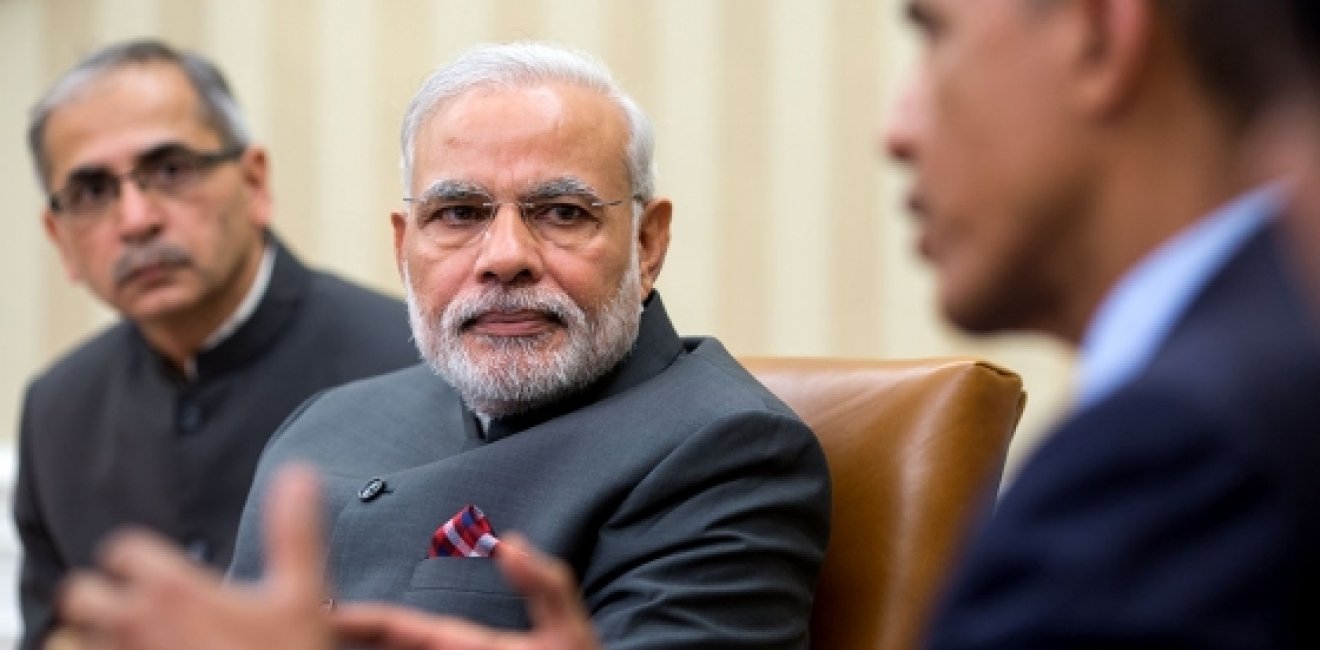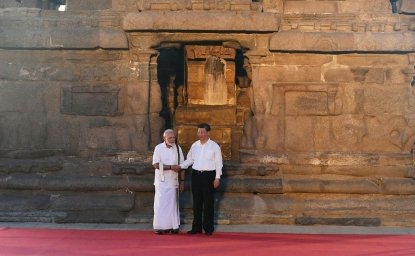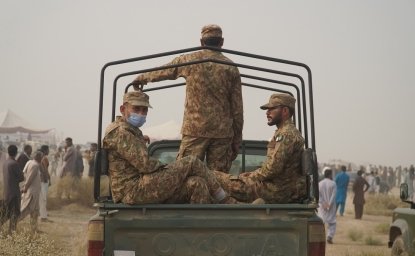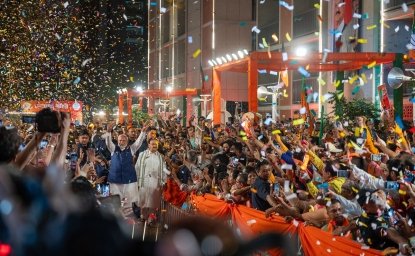Is the Honeymoon Over for Narendra Modi?
"India’s prime minister may be taking the world by storm, but he is suffering major setbacks at home," writes Michael Kugelman.
"India’s prime minister may be taking the world by storm, but he is suffering major setbacks at home," writes Michael Kugelman.

September 24, Narendra Modi arrives in America for a six-day visit. As with many of his previous international visits as India’s prime minister, it will feature ample substance—and plenty of pomp and circumstance.
Modi will participate in several meetings in New York, including dinner with Fortune 500 CEOs and a third meeting in 12 months with President Barack Obama. Modi will also travel to California—the first time in more than 30 years that an Indian premier has been to that state. Modi’s California itinerary will include discussions with top Silicon Valley start-ups and a Town Hall meeting with Facebook’s Mark Zuckerberg—an event “you shouldn’t miss,” Modi posted on his Facebook page.
Modi’s trip to the United States marks the 29th foreign trip he has made during his 16 months as prime minister. After attracting criticism for appearing nervous in a speech he delivered in Brazil early in his term, he has seemingly done nothing but dazzle abroad. He has inked big deals—from a uranium deal with Australia to a mammoth $75 billion infrastructure investment accord with the United Arab Emirates. He has hobnobbed with celebrities, rubbed shoulders with top executives, and regaled adoring members of the Indian diaspora from New York to Sydney and Toronto to Berlin.
If only things were going so well back home.
In recent weeks, Modi has suffered blow after blow to his domestic policy agenda—and particularly to his economic reform plan, which millions of Indian voters gave him a large mandate to craft and implement.
On September 9, the government decided to abandon, for now, its quest to institute a uniform goods and services tax, a single nationwide duty that would replace the various taxes levied by India’s states and bring some much-needed order to India’s tax system. A GST, according to economists, could increase GDP by 2 percent. The government shelved the plan when it concluded that it wouldn’t be approved in Parliament.
This was a particularly bitter defeat for New Delhi, given that it had already abandoned another big-bang tax reform attempt earlier this year: the phase-out of retrospective taxation. Such a move would have been “too much, too soon,” according to Finance Minister Arun Jaitley.
Modi has also suffered setbacks on proposed land and labor reforms. This summer, his government suspended efforts to get legislation passed that would facilitate the acquisition of farmland for industrial and infrastructure purposes. Additionally, New Delhi’s plans to pass new labor laws that give employers more flexibility to hire and fire workers have been vociferously opposed by major unions and millions of low-wage workers. They staged a nationwide strike in early September.
This isn’t to say that Modi’s reform efforts have been a total failure. He has kickstarted several dozen stalled projects to boost infrastructure—one of India’s most glaring needs. He has also removed controls on diesel costs, a small step toward easing the government’s heavy regulation of the energy sector, which generates inefficiencies and discourages foreign investors. Furthermore, several Indian state governments have in fact implemented some of the reform projects proposed by Modi.
Still, these encouraging signs for New Delhi have not assuaged the concerns of many Indian and foreign investors, who admit they are getting restless after hearing many promises but seeing few results. Earlier this month, prominent commodities trader Jim Rogers announced that he had sold off all his Indian shares and was moving into different markets.
There are various reasons for Modi’s struggles at home. His reform plan is meant to replicate what he did in Gujarat, where he was chief minister for 12 years, yet Gujarat boasts an entrepreneurial and market-friendly environment that is sorely lacking in many of India’s other states (the India Entrepreneurship Report 2014, released earlier this year by Amway India, ranks Gujarat as India’s top state on indices such as infrastructure support, entrepreneurial confidence, and growth-oriented economy). Additionally, India’s upper house of Parliament and several major states are not controlled by Modi’s Bharatiya Janata Party (BJP). Not surprisingly, most of the Indian states that have not implemented reforms urged by Modi are run by the opposition Congress party—including Assam, Himachal Pradesh, Kerala, and Uttarakhand.
Furthermore, even a decisive, can-do, visionary leader like Modi can’t single-handedly remove structural constraints to reform—from corruption to entrenched populist sentiment that abhors the idea of full-scale economic liberalization. Modi, for example, has been unable or unwilling to phase out subsidies in a big way, or to push back against farmers’ resistance to his envisioned land acquisitions bill. The political obstacles are simply too great. Some observers are even advising Modi to scale back his pro-business reform model and instead focus more on education and health care.
Ultimately, Modi is finding out what Obama discovered after his first year in power: when you run and win an electoral campaign rooted in the soaring rhetoric of hope and change, you produce outsize expectations that are difficult if not impossible to meet.
This prompts an important question: If New Delhi’s economic reform plan continues to lapse, and if the economy’s struggles intensify (GDP growth slipped to 7 percent in the quarter ending this past June, compared to 7.5 percent in the previous quarter), then will the BJP’s rank and file grow restless? And if so, will the government then feel a need to appease its conservative base by redirecting attention to its social agenda—one that emphasizes Hindu nationalism?
For now, such questions are premature. India’s economy, despite its recent hiccups, is by no means in deep crisis. And Modi is in no imminent political danger; he remains quite popular. In January 2015 he was dealt a major blow when the Aam Aadmi Party defeated the BJP in a regional election in Delhi, and several months later a poll found his government somewhat less popular than it was back in December. However, a more recent poll, from August 2015, gave him a nearly 80 percent approval rating—only slightly less than the 82 percent rate he enjoyed in August 2014, when he was still basking in the glow of his lopsided election victory.
Significantly, Modi is also polling relatively well in Bihar, a large and poor state that is not controlled by the BJP and that will be holding an election in the coming days. Majorities of Biharis say they believe Modi “cares for Bihar,” while Bihar Chief Minister Nitin Kumar’s popularity rate registers at only a few percentage points higher than Modi’s.
Still, potential trouble could be brewing. In recent months, middle class residents of Gujarat have staged protests demanding that they receive jobs through affirmative action programs that are typically reserved for poor, low caste Indians. This movement is led by the Patel clan—members of the BJP’s rank and file that have contributed mightily to Modi’s electoral success for more than a decade. There are approximately 10 million Patels in Gujarat, and one rally last month drew 500,000 of them.
The implications are clear: Modi’s hard-core supporters are getting restless as they start to feel the pinch of a slowing economy that he has struggled to fix.
Amid this turmoil at home, Modi’s traveling road show abroad continues apace. In November, he’ll head to the United Kingdom—the first visit by an Indian premier in almost a decade—where he will speak to 70,000 British Indians in London’s Wembley Arena. This event is billed as the “biggest reception for any foreign head of government” in Britain. Also on tap in November is a visit to Turkey, the first by an Indian prime minister in 13 years, as well as a much-ballyhooed visit to Israel, the first ever by an Indian prime minister.
Modi was swept into power on a promise to establish bold new reforms that would strengthen India’s economy and allow it to reach its full potential. And yet it is his foreign policy—which garnered just one page of discussion in the BJP’s 2014 election manifesto, barely more than sports—that seemingly has a greater chance of being transformational.
The opinions expressed here are solely those of the author.
This article was originally publised in Foreign Policy.


The Indo-Pacific Program promotes policy debate and intellectual discussions on US interests in the Asia-Pacific as well as political, economic, security, and social issues relating to the world’s most populous and economically dynamic region. Read more




